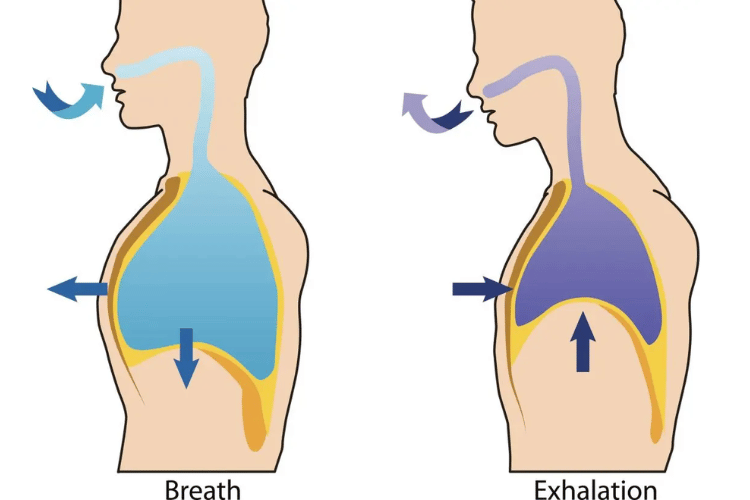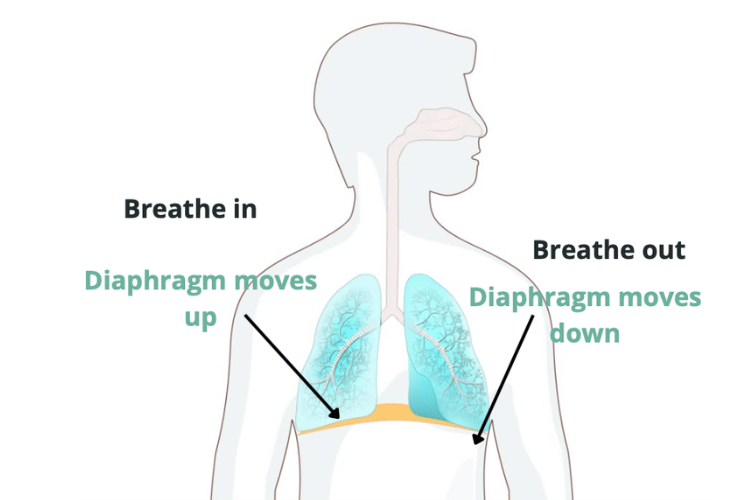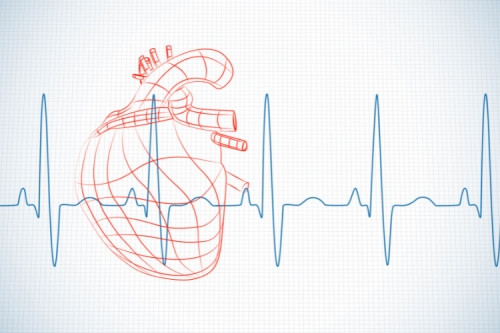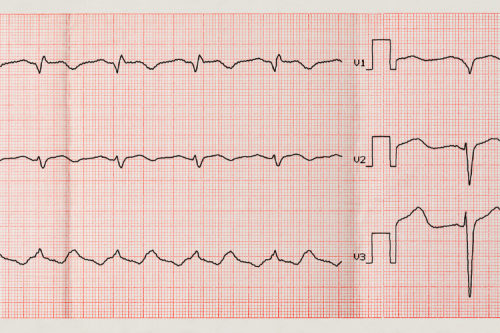
Paradoxical breathing is an abnormal breathing pattern where the chest and abdomen move in opposite directions during respiration. This condition can be a sign of underlying respiratory or neurological issues and often requires medical attention. In this blog, we’ll discuss the causes, symptoms, and potential treatments for paradoxical breathing, helping you understand when to seek help and what to expect.
Understanding Paradoxical Breathing
Paradoxical breathing is a condition that disrupts the normal mechanics of respiration, often indicating an underlying issue with the respiratory system or the muscles involved in breathing. Recognizing and understanding this phenomenon is essential for identifying potential health concerns and seeking appropriate treatment.What is Paradoxical Breathing?

What is Paradoxical Breathing?
The Role of Diaphragmatic Breathing
Diaphragmatic breathing, also known as belly breathing, plays a crucial role in normal respiration. The diaphragm is the primary muscle responsible for drawing air into the lungs. When functioning correctly, it contracts and flattens during inhalation, creating a vacuum that pulls air into the lungs. This process allows for efficient oxygen exchange and helps maintain a steady breathing rhythm. In paradoxical breathing, the diaphragm may not function properly due to weakness, paralysis, or injury. This can force the accessory muscles of the chest and neck to take over, leading to shallow and labored breathing. Over time, this compensatory mechanism can cause muscle fatigue and exacerbate respiratory difficulties. Understanding the role of the diaphragm highlights the importance of its proper function in maintaining effective and healthy breathing patterns.How It Differs from Normal Breathing
The key difference between paradoxical breathing and normal breathing lies in the movement of the chest and abdomen. In normal breathing, these areas work in harmony, with the chest expanding outward and the abdomen rising during inhalation. This coordinated movement ensures that the lungs can fully expand, allowing for optimal oxygen intake and carbon dioxide removal. In paradoxical breathing, this harmony is disrupted. The chest may move inward while the abdomen rises, or the abdomen may contract while the chest expands. This inefficient pattern reduces lung capacity and can lead to inadequate oxygenation of the blood. Additionally, paradoxical breathing often requires more effort, causing strain on the respiratory muscles and leading to symptoms like shortness of breath, dizziness, or even respiratory distress in severe cases. By understanding the mechanics of paradoxical breathing and how it differs from normal respiration, individuals and healthcare providers can better identify the condition and address its underlying causes. Early recognition and intervention are critical for preventing complications and improving respiratory function.Understanding the Causes of Paradoxical Breathing
Neuromuscular Factors
Paradoxical breathing, a condition where the chest and abdomen move in opposite directions during respiration, can often be attributed to neuromuscular issues. Disorders affecting the nerves or muscles responsible for breathing, such as amyotrophic lateral sclerosis (ALS) or muscular dystrophy, can disrupt the coordination required for normal respiratory movements. When the diaphragm, the primary muscle involved in breathing, weakens or becomes paralyzed, it fails to contract effectively. This leads to an abnormal inward movement of the chest during inhalation, a hallmark of paradoxical breathing. In some cases, conditions like Guillain-Barré syndrome or spinal cord injuries can impair the neural signals that control the diaphragm and intercostal muscles. This disruption further exacerbates the irregular breathing pattern. Individuals with these neuromuscular conditions may also experience additional symptoms, such as fatigue, shortness of breath, and difficulty performing physical activities, as their bodies struggle to maintain adequate oxygen levels.Respiratory Conditions
Certain respiratory disorders are also significant contributors to paradoxical breathing. Chronic obstructive pulmonary disease (COPD), for instance, can lead to hyperinflation of the lungs, which places excessive pressure on the diaphragm. Over time, this pressure weakens the diaphragm, causing it to function abnormally. Similarly, severe asthma attacks can result in airway obstruction, forcing the body to adopt irregular breathing patterns to compensate for the reduced airflow. Sleep apnea is another respiratory condition linked to paradoxical breathing. During episodes of apnea, the airway becomes partially or completely blocked, causing the chest and abdomen to move out of sync as the body struggles to draw in air. This phenomenon is particularly noticeable during sleep, when the muscles are more relaxed. In advanced cases, respiratory failure may develop, requiring immediate medical intervention to restore normal breathing.Physical Trauma and Injury
Physical injuries, especially those affecting the chest or diaphragm, are a common cause of paradoxical breathing. Rib fractures, for example, can destabilize the chest wall, leading to abnormal movements during respiration. In severe cases, a condition known as flail chest may occur, where multiple rib fractures result in a segment of the chest moving independently from the rest of the ribcage. This creates the characteristic "see-saw" motion associated with paradoxical breathing. Diaphragmatic injuries, whether due to blunt trauma, surgical complications, or penetrating wounds, can also impair the muscle's ability to contract properly. This often results in the abdomen moving inward during inhalation, rather than outward. Additionally, spinal cord injuries, particularly those affecting the cervical region, can disrupt the neural pathways that control the diaphragm, further contributing to irregular breathing patterns.Recognizing the Symptoms of Paradoxical Breathing
Physical Signs to Look For
Paradoxical breathing is often characterized by distinct physical signs that are easily noticeable. One of the most prominent indicators is the abnormal movement of the chest and abdomen during breathing. Instead of expanding together during inhalation, the chest may collapse inward while the abdomen moves outward, or vice versa. This irregular motion is particularly evident when the individual is lying down or during deep breaths. Other physical symptoms may include visible strain in the neck or shoulder muscles as the body attempts to compensate for inefficient breathing. In severe cases, the skin around the ribs may appear to sink in with each breath, a phenomenon known as retractions. These signs are often accompanied by audible wheezing or gasping sounds, especially in individuals with underlying respiratory conditions.
Impact on Oxygen Levels
Paradoxical breathing can significantly affect the body’s ability to maintain adequate oxygen levels. The inefficient movement of the diaphragm and chest muscles disrupts the normal airflow into the lungs, leading to reduced oxygen intake. As a result, individuals may experience symptoms such as shortness of breath, rapid breathing, or a feeling of suffocation. Low oxygen levels, or hypoxemia, can also manifest in other ways. For instance, the skin, lips, or nail beds may take on a bluish tint, a condition known as cyanosis. This is a clear indication that the body is struggling to deliver sufficient oxygen to vital organs. Over time, chronic oxygen deprivation can lead to fatigue, confusion, and difficulty concentrating, further impacting the individual’s quality of life.Potential Complications
If left untreated, paradoxical breathing can lead to a range of complications, some of which may be life-threatening. One of the most immediate risks is respiratory failure, where the lungs are unable to provide enough oxygen to the body or remove carbon dioxide effectively. This condition requires urgent medical intervention, often involving mechanical ventilation to support breathing. Another potential complication is the development of secondary infections, such as pneumonia. The irregular airflow and reduced lung function create an environment where bacteria and other pathogens can thrive. Additionally, prolonged oxygen deprivation can strain the heart, increasing the risk of cardiovascular issues such as arrhythmias or heart failure. In children and infants, paradoxical breathing can interfere with normal growth and development. The lack of sufficient oxygen can impair brain function, leading to developmental delays or learning difficulties. Recognizing and addressing these complications early is crucial to prevent long-term health consequences.Paradoxical Breathing in Infants and Children
Paradoxical breathing, a condition where the chest moves inward during inhalation instead of expanding outward, can be particularly concerning in infants and children. This abnormal breathing pattern often indicates an underlying respiratory or neurological issue that requires immediate attention. Unlike adults, whose respiratory systems are more developed, children and infants are more vulnerable to complications due to their smaller airways and less mature lung function. Understanding the symptoms, causes, and importance of early intervention is crucial for parents and caregivers to ensure timely medical care.
Identifying Symptoms in Young Children
Recognizing paradoxical breathing in young children can be challenging, especially since they may not be able to articulate their discomfort. However, there are several observable signs that can help caregivers identify the condition.- Chest Retractions: One of the most noticeable symptoms is the inward movement of the chest or abdomen during inhalation. This is often accompanied by visible effort to breathe.
- Nasal Flaring: Infants and young children may exhibit flaring of the nostrils as they struggle to take in enough oxygen.
- Rapid Breathing: An increased respiratory rate, often accompanied by shallow breaths, is another common indicator.
- Cyanosis: A bluish tint around the lips, fingertips, or face may appear, signaling a lack of oxygen in the blood.
- Audible Sounds: Wheezing, grunting, or other unusual breathing noises can also point to respiratory distress.
Underlying Causes Specific to Infants
In infants, paradoxical breathing is often linked to specific developmental or medical conditions. Their respiratory systems are still developing, making them more susceptible to certain issues. Below are some common causes:- Premature Birth: Premature infants often have underdeveloped lungs, which can lead to respiratory distress and abnormal breathing patterns.
- Congenital Diaphragmatic Hernia (CDH): This condition occurs when a hole in the diaphragm allows abdominal organs to move into the chest cavity, impairing lung function.
- Neuromuscular Disorders: Conditions like spinal muscular atrophy or muscular dystrophy can weaken the muscles involved in breathing, leading to paradoxical movements.
- Airway Obstructions: Blockages caused by mucus, foreign objects, or anatomical abnormalities can disrupt normal airflow and result in labored breathing.
- Infections: Severe respiratory infections, such as bronchiolitis or pneumonia, can also trigger paradoxical breathing in infants.
Importance of Early Intervention
Early intervention is critical when dealing with paradoxical breathing in children and infants. Delayed treatment can lead to severe complications, including hypoxia, organ damage, or even respiratory failure. Addressing the issue promptly not only improves the child’s immediate health but also reduces the risk of long-term consequences. Medical professionals often use a combination of diagnostic tools, such as chest X-rays, blood oxygen level tests, and physical examinations, to identify the root cause of the condition. Treatment may involve oxygen therapy, mechanical ventilation, or surgical interventions, depending on the severity and underlying cause. For parents and caregivers, understanding the importance of early action cannot be overstated. Being vigilant about symptoms and seeking timely medical advice can make a significant difference in the child’s recovery and overall well-being.Effective Treatment Options for Paradoxical Breathing
Paradoxical breathing, a condition where the chest and abdomen move in opposite directions during respiration, can significantly impact oxygen intake and overall health. Addressing this issue requires a combination of targeted therapies, medical interventions, and lifestyle adjustments. The choice of treatment depends on the underlying cause, severity, and the patient’s overall health. Below, we explore various approaches to managing this condition effectively.Breathing Techniques and Exercises to Improve Respiratory Function
Breathing exercises are often the first line of treatment for individuals experiencing paradoxical breathing. These techniques aim to retrain the respiratory muscles, improve lung capacity, and restore normal breathing patterns. Diaphragmatic breathing, for instance, focuses on engaging the diaphragm rather than the chest, promoting a more efficient oxygen exchange. Patients are encouraged to lie flat, place one hand on their abdomen, and practice deep, controlled breaths to strengthen the diaphragm. Another effective method is pursed-lip breathing, which helps regulate airflow and reduce shortness of breath. This technique involves inhaling deeply through the nose and exhaling slowly through pursed lips, creating resistance that stabilizes the airways. Additionally, yoga-based practices, such as pranayama, can enhance respiratory control and reduce stress, which often exacerbates breathing irregularities. For individuals with severe symptoms, respiratory therapists may recommend structured programs that include biofeedback. These programs use visual or auditory cues to help patients monitor and adjust their breathing patterns in real time, ensuring consistent progress.Medical Interventions for Severe Cases
In cases where paradoxical breathing is caused by underlying medical conditions, such as neuromuscular disorders or trauma, medical interventions may be necessary. Non-invasive ventilation, such as continuous positive airway pressure (CPAP) or bilevel positive airway pressure (BiPAP), is commonly used to support breathing during sleep or periods of respiratory distress. These devices help maintain airway patency and improve oxygenation. For patients with structural abnormalities, such as a collapsed lung or rib fractures, surgical procedures may be required to correct the issue. Thoracic surgery, for example, can stabilize the chest wall and restore normal respiratory mechanics. In some instances, medications like bronchodilators or corticosteroids are prescribed to address inflammation or airway obstruction contributing to the condition. It is crucial for patients to work closely with their healthcare providers to determine the most appropriate medical intervention. Regular monitoring and follow-ups ensure that the chosen treatment remains effective and that any complications are addressed promptly.Long-term Management Strategies for Sustained Improvement
Managing paradoxical breathing over the long term involves a combination of lifestyle changes, ongoing therapy, and regular medical care. Physical therapy plays a vital role in strengthening the respiratory muscles and improving overall endurance. Therapists may incorporate exercises that target the intercostal muscles and diaphragm, ensuring that the patient maintains optimal respiratory function. Lifestyle modifications, such as maintaining a healthy weight and avoiding smoking, are equally important. Excess weight can place additional strain on the respiratory system, while smoking exacerbates inflammation and damages lung tissue. Patients are also encouraged to manage stress through mindfulness practices, as anxiety can worsen breathing irregularities. For individuals with chronic conditions, such as COPD or sleep apnea, long-term use of assistive devices like CPAP machines may be necessary. Regular check-ups with a pulmonologist or respiratory specialist ensure that the treatment plan is adjusted as needed to accommodate changes in the patient’s condition. By combining these strategies, patients can achieve significant improvements in their breathing patterns and overall quality of life.Frequently Asked Questions
Q: What is paradoxical breathing?
A: Paradoxical breathing is a condition where the chest and abdomen move in opposite directions during breathing. Normally, during inhalation, the diaphragm moves downward, causing the chest to expand and the abdomen to rise. In paradoxical breathing, the chest may contract inward while the abdomen expands, indicating a disruption in the normal breathing process.
Q: What causes paradoxical breathing?
A: Paradoxical breathing can result from various factors, including respiratory distress, chest trauma, or conditions that weaken the respiratory muscles, such as muscular dystrophy or Guillain-Barré syndrome. Chronic obstructive pulmonary disease (COPD), rib fractures, or neurological disorders can also contribute to this abnormal breathing pattern.
Q: What are the signs of paradoxical breathing?
A: Signs of paradoxical breathing include irregular chest and abdominal movements, shortness of breath, and difficulty inhaling or exhaling effectively. Observing the rib cage and abdomen during breathing may reveal the chest moving inward while the abdomen expands during inhalation, which is a hallmark of this condition.
Q: How does paradoxical breathing affect lung function?
A: Paradoxical breathing can impair lung function by disrupting the normal mechanics of respiration. The improper movement of the diaphragm and chest wall can reduce airflow, making it difficult to breathe efficiently. Over time, this can lead to complications such as respiratory failure or conditions like sleep apnea.
Q: What breathing exercises can help with paradoxical breathing?
A: Breathing exercises that focus on strengthening the diaphragm and improving coordination between the chest and abdomen can be beneficial. Diaphragmatic breathing, where the focus is on using the diaphragm to control inhalation and exhalation, is particularly effective. These exercises can help restore a more natural breathing pattern over time.
Q: How is paradoxical breathing diagnosed?
A: Diagnosis of paradoxical breathing typically involves a physical examination, imaging tests, and an evaluation of the patient’s breathing patterns. Healthcare providers will assess the movement of the chest and abdomen and may use tools like X-rays or pulmonary function tests to identify underlying causes.
Q: What treatment options are available for paradoxical breathing?
A: Treatment for paradoxical breathing depends on the underlying cause. Options may include physical therapy to strengthen respiratory muscles, respiratory support like CPAP therapy for associated sleep apnea, or addressing the root condition, such as managing COPD or repairing chest injuries. In severe cases, mechanical ventilation may be required.
Q: Can paradoxical breathing occur in infants and children?
A: Yes, paradoxical breathing can occur in infants and children, often due to respiratory infections, airway obstructions, or congenital abnormalities. It is especially important to monitor young children for signs of respiratory distress, such as irregular chest movements or difficulty breathing, and seek medical attention promptly.
Q: Can paradoxical breathing lead to further complications?
A: If left untreated, paradoxical breathing can lead to serious complications, including respiratory failure, reduced lung capacity, and worsening of underlying health conditions. Early diagnosis and treatment are essential to prevent these issues and improve overall respiratory function.
Conclusion
Paradoxical breathing is more than just an unusual breathing pattern—it can indicate serious health concerns that require prompt evaluation and treatment. By recognizing the symptoms and understanding the potential causes, you can take the necessary steps to address this condition and protect your respiratory health. Always consult a healthcare professional if you notice signs of paradoxical breathing.








 Login with Google
Login with Google Login with Facebook
Login with Facebook